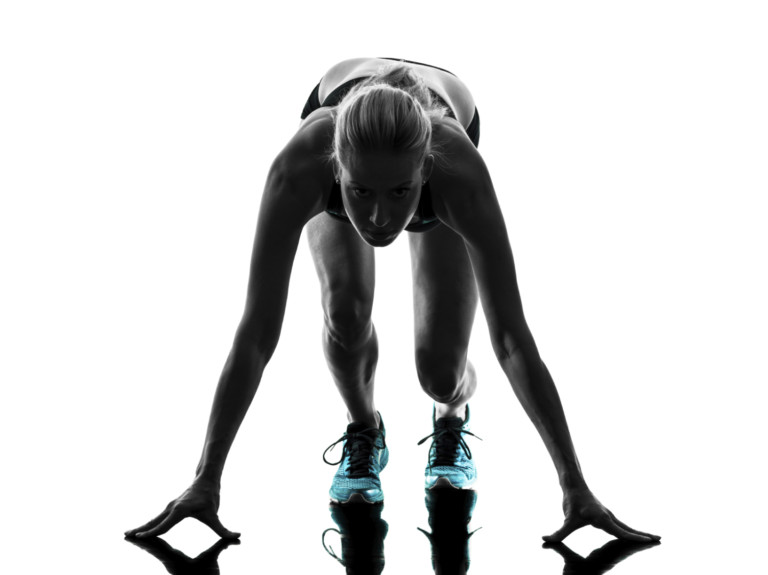
One of the most popular critiques of a ketogenic diet – a diet that’s high in fat and low in carbs – is that it isn’t good for athletes. The argument is usually that you need carbs to produce glycogen, a stored form of sugar that fuels your muscles. As a result, most doctors and trainers suggest high-carb diets for athletes.
If you’ve been working out while eating Bulletproof, Paleo, keto, or any other variation on a high-fat, low-carb diet, here’s some good news: brand new research shows that you not only don’t need carbs for athletic performance, you can actually gain an advantage if you cut them out. Let’s talk about how ketosis can kick your athletic performance into a higher gear.
Why you don’t need carbs to train hard
A groundbreaking new study out of UConn found that low-carb endurance athletes perform just as well as high-carb endurance athletes, if not better. The results challenge nearly 50 years of research saying the opposite.
Until now, most studies have concluded that you top out at around 10% of energy recruited from fat [1] and for the rest you rely mostly on glycogen, a form of sugar stored in your muscles and liver. That’s the main reason high-carb diets have been the standard for athletes for so many years. With a low-carb diet, your glycogen stores empty quickly, you run out of fuel, and you start breaking down your muscles for energy. Right?
Well, maybe not. If you teach your body to prefer fat for fuel you can work out intensely without any problems, according to this new study.
The paper’s authors measured the performance of ultra-endurance runners who regularly run upwards of 100 miles. Here’s how they set it up:
- Half of the participants ate low-carb (<20% of calories from carbs) for 6 months
- The other half ate high-carb (>55% of calories from carbs) for 6 months
- On test day, athletes ran for 3 hours. The researchers measured the runners’ energy expenditure and gathered blood, muscle tissue, saliva, and a variety of other samples. They then pieced everything together to better understand what each group was burning for fuel, and how hard they had to work
The results were impressive. The ketogenic runners showed, to quote the authors, “extraordinarily high rates of fat oxidation.” [2]
In other words, the low-carb athletes were fat-burning machines. They recruited tremendous amounts of energy from fat during the 3-hour run and showed no more fatigue than the high-carb runners did. What’s even more fascinating is that both groups had the same muscle glycogen levels during and after exercise, and they weren’t breaking down their muscles to do it.
The takeaway is that a ketogenic diet can help you:
- Massively increase the fat you burn
- Preserve muscle tissue
- Keep exercising like a boss without metabolic downsides, even at an elite level. In fact, the study’s lead author said that several of the high-carb ultra-marathoners in the study switched over to a low-carb diet after seeing how well the ketogenic participants performed.
Other benefits to low-carb training
Training on a high-fat, low-carb (HFLC) diet can give you several other advantages.
- Fat and cholesterol support your testosterone levels, which leads you to burn more fat. Carbs – especially simple carbs – cause your testosterone to drop [3], making you store more fat.
- Your energy stores are deeper if you’re running on fat. The average person can only hold about 500 grams of glycogen at a time, but as we all know too well, fat stores are more or less bottomless.
- You hold less water weight on a low-carb diet. Without that bloating you’ll be faster and lighter on your feet, which can make all the difference in the world if you’re a competitive athlete. You’ll also look leaner. That’s what’s really important.
How you can mix ketosis and exercise
If you want to burn more fat without sacrificing muscle or athletic performance, try the following:
- Eat a high-fat, low-carb diet like the Bulletproof Diet.
- Get 5-20% of your calories from carbs each day. The study’s participants ate 20% carbs, but they were running for hours on a regular basis. If you don’t fit that bill you may want to try fewer carbs and more fat so you stay in ketosis. You can also try skipping carb refeed days to get into deeper ketosis. Experiment and find a level that works for you.
- Eat fat before exercising so your muscles have quick access to fuel. Bulletproof Coffee is a great pre-workout supplement.
- Get your carbs from non-starchy, nutrient-dense veggies like broccoli, bok choy, fennel, and kale.
What about lifting weights?
You can build muscle on a high-fat, low-carb diet too. A not-yet-published study presented at the 2016 National Metabolic Therapeutics Conference found that people on a ketogenic diet and a lifting program put on lean mass without issue.
However, the same study found that people on a cyclical ketogenic diet (5 days of low-carb, then 2 higher-carb days) put on less muscle and were only in deep ketosis a couple days each week. Bulletproof recommends one carb refeed day each week with a maximum of around 150g of carbs, so you may not run into the same issue, but if you find you’re not putting on enough lean muscle you can try skipping the higher-carb day. Stay tuned for a more in-depth breakdown of the ketogenic weight-lifting study; it’s due to publish soon.
Upping your fat intake and limiting carbs is a powerful way to improve your performance, both in and out of the gym. It’s easy to get caught up in ratios and percentages when you’re eating low-carb. Remember that we all have different genetic backgrounds, and you very well may find that cyclical ketosis works better for you than being in ketosis all the time does. Focus on how you feel and play around with the fat-to-carb ratio until you find something that works for you. And remember to subscribe below if you want more cutting-edge info about how to upgrade your biology. Thanks for reading!
[expand title=”Click to read the complete list of references.” swaptitle=”Click to hide references.”]
- http://www.ncbi.nlm.nih.gov/pmc/articles/PMC2885974/
- http://www.sciencedirect.com/science/article/pii/S0026049515003340
- http://www.ncbi.nlm.nih.gov/pubmed/22804876










